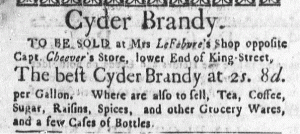GUEST CURATOR: Evan Sutherland
What was advertised in a colonial American newspaper 250 years ago today?

“Cyder Brandy TO BE SOLD at Mrs. LeFebure’s Shop.”
According to Patricia Cleary, the role of women as shopkeepers in the eighteenth century was an expected extension of their household duties.[1] One such example could be found in the Massachusetts Gazette, a female shopkeeper named Mrs. LeFebure. The estimated percentage of women shopkeepers during this time had varied. According to a Philadelphia tax list from 1756, thirty-eight women kept shops, which accounted for 42% of the town’s shopkeepers.[2] However, the tax list revealed that male shopkeepers were more prosperous than female shopkeepers. The evidence suggests that many of these women may have been widows, as keeping shop appeared to be a common source of income for widows in the eighteenth century.[3] Gender division was further shown when the widowed shopkeepers were labeled as widows, rather than shopkeepers. Most female shopkeepers only started trade businesses after the death of their husbands. In addition, female shopkeepers portrayed themselves as “arbiters of taste” as they attempted to increase sales and to create and meet demand during the consumer revolution.[4]
**********
ADDITIONAL COMMENTARY: Carl Robert Keyes
Yesterday Ceara Morse examined an advertisement for a dozen types of spirits produced in Savannah by Henry Snow, “Distiller from London.” Today’s advertisement featured only one kind of alcohol, “Cyder Brandy,” sold at Mrs. LeFebure’s shop on King Street in Boston. The wording makes it difficult to determine whether LeFebure produced the cider brandy herself or merely sold spirits distilled by an associate.
Even if she did not run an operation as extensive as Henry Snow’s or possess his level of experience and expertise, it likely would have been within LeFebure’s ability to distill cider brandy. After all, two recipes appeared in a cookbook for “ALL Good Housewives,” John Nott’s Cook’s and Confectioner’s Dictionary: Or, the Accomplished Housewife’s Companion, published in London in 1723. The recipes have been reproduced below. Although the recipes indicate that they required some specialized equipment (including a “Copper Body and Head” and a “refrigerator Worm”), they do not suggest that LeFebure or other “housewives” needed access to a “large Distill-House,” such as the one offered for sale or rent in the advertisement immediately below the notice that LeFebure sold “Cyder Brandy.”
While distilling may have been a predominantly masculine occupation in eighteenth-century America, today’s advertisement and Nott’s cookbook suggest that women participated as well, even if on a smaller scale than their male counterparts. Unlike Snow, LeFebure did not derive her entire livelihood from selling (and perhaps making) spirits but instead diversified her inventory. The cider brandy she sold appeared alongside various “Grocery Wares,” including coffee, tea, and sugar. Perhaps this contributed to making it more acceptable for her to peddle alcohol.
**********
From The Cook’s and Confectioner’s Dictionary: Or, the Accomplished Housewife’s Companion
LET your Cider be fine, and past its Fermentations, but not very stale; and put to it a Pint and a half of Brandy, or Sprits drawn off of Cider, to each Gallon of Cider; and add a Quart of Cider Sweets to every four Gallons more or less, according to the Tartness or Harshness of the Cider; the Spirits and Sweets must first be mixed together, and then mix’d with an equal quantity of Cider; then put them into the Cask of Cider; and stir all together well with a Stick at the Bung-hole for a quarter of an Hour, then stop up the Bung-hole close, and roll the Cask about ten or twelve time to mix them well together. Set it by for three or four Months, then bottle it up, or you may drink it.
TAKE Eager, very hard or sowr Cider, (for that yields by much the more Spirits) twelve Gallons; distill it as other Spirits are distill’d, in a Copper Body and Head, and a refrigeratory Worm running thro’ a Cask of cold Water, under whose Beak as Receiver is placed. From which, with a gentle Fire draw off two Gallons of Cider Brandy, or Spirits, for the use mentioned in the last Receipt. You may distil on as long as any Spirits will run, for other uses.
**********
[1] Patricia Cleary, “‘She Will Be in the Shop’: Women’s Sphere of Trade in Eighteenth-Century Philadelphia and New York,” Pennsylvania Magazine and History and Biography 119, no. 3 (July 1995): 182.
[2] Cleary, “She Will Be in the Shop,” 185.
[3] Cleary, “She Will Be in the Shop,” 186.
[4] Cleary, “She Will Be in the Shop,” 200.

